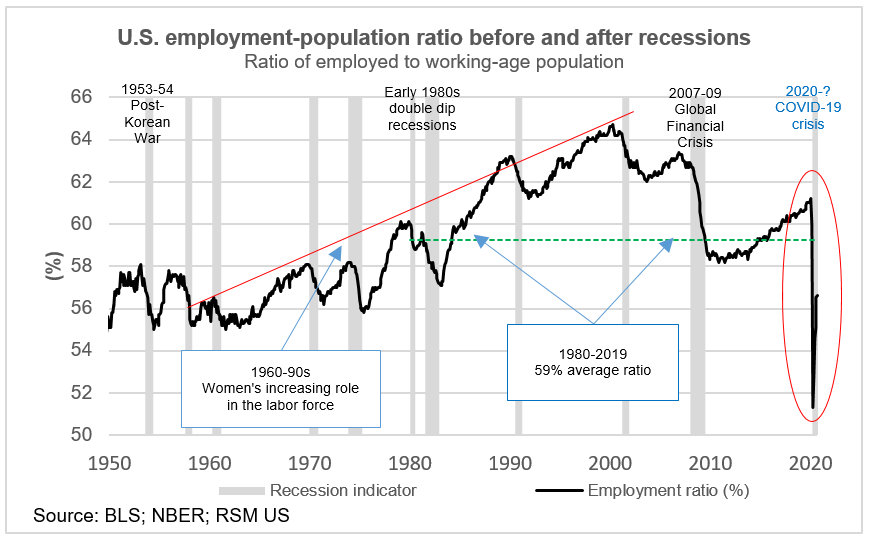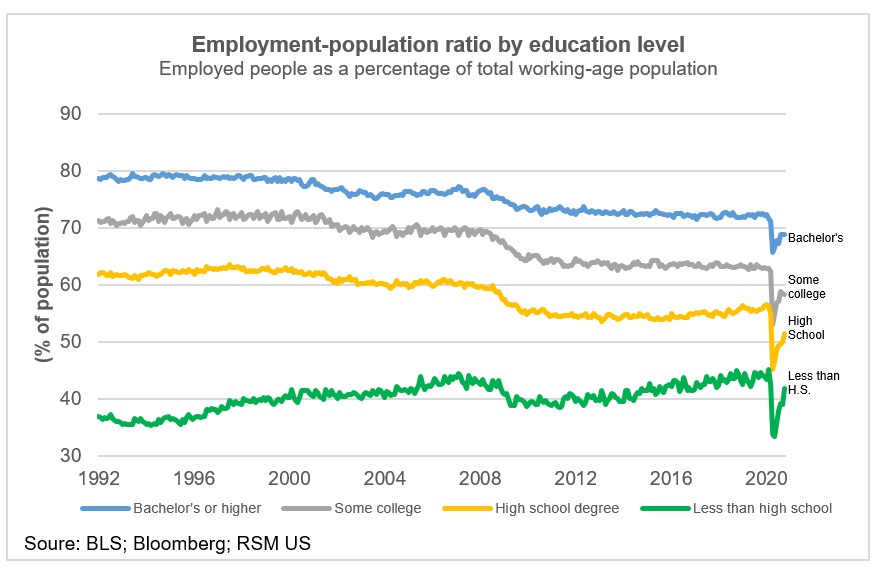November jobs preview: Employment-to-population ratio and the likelihood of a double-dip recession

Economic growth likely slowed in November because of the significant breakout of COVID-19 throughout the country. As such, we expect that improvement in the labor market will continue to slow to near 370,000 jobs on the month with the unemployment rate falling to 6.8% when the Labor Department releases its jobs data on Friday.
We expect wages to be flat on the month with no increase in hours worked.
We expect wages to be flat on the month, with no increase in hours worked. That does not bode well for the holiday shopping season, which has had an uninspiring start.
Employment-to-population ratio
Although employment opportunities have improved in recent months, the pandemic has nonetheless reversed 40 years of progress virtually overnight. The economy may be producing at its potential a year from now, but it will be a number of years before the labor market will return to pre-pandemic levels.
Before the economic shutdown, 61% of the working-age population was employed. By April, only 51% was still working. Then, as local economies were reopened during the spring and summer, that ratio moved back up to 57% in October. That’s an improvement, but is still the lowest level since the succession of energy shocks in the 1970s and the 1983 double-dip recession that shook the global economy to its core.

This improvement in employment comes at a time when we find ourselves facing opposing forces—a second wave of the pandemic threatening once again to bring the economy to a halt versus technological advances in immunology that could protect us from the spread of COVID-19 and perhaps future diseases.
The brunt of the health crisis lands on the less-educated, lower-income members of our society. Using the intersection of employment and education as our benchmark, we can see that the more education you have, the more likely you are to be working, and that the employment-population ratio has not returned to January 2020 levels for any degree of education.
Ironically, however, the employment ratio among those without a high school degree has rebounded to 1992-2015 norms, while the employment ratios for higher-educated groups remain significantly lower.
So although people with a bachelor’s degree or higher are more likely to be furloughed and sitting at home, the person who bags our groceries is more likely to be working, but also more likely to be exposed to the virus. These are essential members of society, but they cannot catch a break.

The risk of a double-dip recession
According to a 2012 report to Congress, “A double-dip recession in the United States is likely to be the consequence of a substantial negative economic shock to an already weak economy.”
The report found that double-dips are rare and have been the consequence—both unintended (1930s Depression era) and intended (1980s)—of policy decisions.
It is not surprising that some have pointed to the risk of a double-dip recession in the United States featuring negative growth during the first quarter of 2021 followed by the combined impact of the second wave of the pandemic and no fiscal aid to blunt its effects.
At this time, we think that there is a 25% chance of a recession over the next 12 months. But given the rapid intensification of the pandemic and its impact on the economy, one cannot completely discount that probability.
Can the employment-to-population ratio be useful as a double-dip indicator? As with all economic data, the monthly employment-population report will certainly lag the daily stream of coronavirus updates and the economic slowdown. Nevertheless, the monthly labor market data is a timely adjunct to the weekly jobless claims data.
We can expect employment levels to reflect the real-time severity of the increase in infections, the rising death toll and the likelihood of having to wait until next year for a coordinated plan to distribute what looks to be an efficacious vaccine.
For these reasons, we expect a deceleration in growth to 2.75% in the fourth quarter and to 2% in the first quarter next year, but not a double-dip recession.
Keep in mind that the global economy was already tottering on the edge before the coronavirus outbreak—the manufacturing sector had already entered a recession. And several more months of reduced employment will have both short-term and long-term effects on the propensity to spend and invest, all of which suggests the need for robust fiscal policy action sooner than later.
For more information on how the coronavirus is affecting midsize businesses, please visit the RSM Coronavirus Resource Center.
